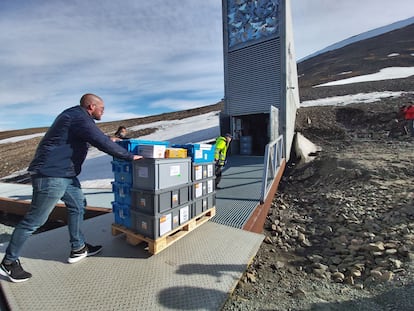Scientists are reviving proteins from billions of years ago to fight diseases in human cells
A study by a group of Spanish scientists demonstrates how to create new gene-editing systems with molecules that no longer exist in nature

For years, scientists from all over the world have been searching for microbes in the ice of Antarctica, in the deepest trenches of the oceans and in the most hostile volcanic environments on the planet. The goal is to track down new proteins that can be used to improve gene-editing techniques. This could open the door to a new era of science and medicine, in which a multitude of diseases could be cured by correcting patients’ faulty genomes with astonishing ease.
Today, a study has been published by a group of Spanish scientists who haven’t just searched for new molecules in space – they have searched for them in time. The team has managed to resurrect proteins from organisms that have been extinct for billions of years.
The researchers have focused on recreating Cas9 enzymes – molecules that work like scissors, capable of cutting the DNA of any living being. This is the basis of the CRISPR gene-editing system.
CRISPR is the immune system of many bacteria and archaea. It allows them to embed virus genetic sequences into their own genome, so that if a virus reappears, CRISPR can identify it, while Cas9 enzymes can slash its genome.
Since its development in 2012, the CRISPR gene-editing system has revolutionized biomedical research, making it possible to rewrite the instruction book of any organism. Now, it’s beginning to be utilized to treat certain diseases in humans. However, this gene-editing system isn’t perfect: it can introduce potentially dangerous errors into the genome. The search for safer alternatives is still ongoing.
A pending question in the field of genetics is how the bacterial immune system – which is much older than humanity – came into existence. Searching for an answer, a team made up of some of Spain’s leading gene-editing experts used a technique to reconstruct the genome of extinct organisms. The technique is known as ancestral sequence reconstruction. It uses powerful computers to compare the complete genomes of living organisms – each made up of billions of letters of DNA – and evaluate what the genomes of their common ancestors would look like.
So far, the researchers have made amazing progress to recover Cas proteins from extinct microbes. The oldest one they have discovered is from 2.6 billion years ago. They have also rescued extinct proteins from microorganisms that lived between 37 million to 1 billion years ago.
Researchers have created new CRISPR systems using these ancient proteins, injecting them into human cells. The results – published in the journal Nature Microbiology – show that, despite being so primitive, all these ancient proteins are capable of editing the DNA of modern human cells.
In the early 1990s, biologist Francis Mojica was studying microbes that lived in the hostile environment of the salt flats of Santa Pola, in the Valencian community of Spain. He also analyzed the DNA sequence known as PAM, which allows microbes to distinguish between their own genomes and the genomes of viruses. Without PAMs, a bacterium could easily kill itself. But the new study – of which Mojica is a co-author – indicates that some of the oldest CAS enzymes are capable of cutting DNA accurately without the need for PAM.
Mojica highlights the importance of this discovery to understand the origin and evolution of CRISPR: “Thanks to this recovery, we can see how the immune system of microbes became less harmful to its carriers and increasingly specific for each virus.” In addition, ”this work is important, because it opens up a huge toolbox for creating better CRISPR systems.”
Raúl Pérez-Jiménez – a co-author of the study and a researcher at the Basque Center for Cooperative Research in Nanoscience – also sees a lot of potential in the research. “These are the oldest Cas proteins that have ever been obtained. Now, we’re going to study how we can make them as efficient as the current ones, or even better!”
The earlier proteins may be able to do things that the current CRISPRs cannot, such as cutting both double and single-stranded DNA and RNA sequences at the same time.
“They’re like Swiss army knives. They have scissors, corkscrews, needles, screwdrivers… they’re probably not the best tools, but they have them all,” Pérez-Jiménez notes.
Miguel Ángel Moreno Pelayo – head of genetics at the Ramón y Cajal Hospital in Madrid and another co-author of the work – says that the reconstruction of ancient proteins opens up the possibility of designing new forms of synthetic CRISPR “that do not exist in nature.” Among other projects, he and his team are developing a method of correcting genetic defects in patients living with ALS.
Co-author Lluís Montoliu – a researcher at the National Center for Biotechnology in Madrid – emphasizes another advantage of the primitive Cas proteins. Unlike more modern proteins, they aren’t detected by the human immune system, which means that they’re less likely to be rejected by the immune systems of patients when utilized in future medical applications.
Miguel Ángel Moreno Mateos – an expert in gene-editing at the Andalusian Center for Developmental Biology – celebrates the new study: “Particularly fascinating is the resurrection of ancient Cas9 [proteins] and the analysis of their activity billions of years later. These resurrected Cas9s present new possibilities with considerable potential in biotechnology.” Although, he cautions, “further study and analysis must be carried out for this to become a reality.”
Sign up for our weekly newsletter to get more English-language news coverage from EL PAÍS USA Edition
Tu suscripción se está usando en otro dispositivo
¿Quieres añadir otro usuario a tu suscripción?
Si continúas leyendo en este dispositivo, no se podrá leer en el otro.
FlechaTu suscripción se está usando en otro dispositivo y solo puedes acceder a EL PAÍS desde un dispositivo a la vez.
Si quieres compartir tu cuenta, cambia tu suscripción a la modalidad Premium, así podrás añadir otro usuario. Cada uno accederá con su propia cuenta de email, lo que os permitirá personalizar vuestra experiencia en EL PAÍS.
¿Tienes una suscripción de empresa? Accede aquí para contratar más cuentas.
En el caso de no saber quién está usando tu cuenta, te recomendamos cambiar tu contraseña aquí.
Si decides continuar compartiendo tu cuenta, este mensaje se mostrará en tu dispositivo y en el de la otra persona que está usando tu cuenta de forma indefinida, afectando a tu experiencia de lectura. Puedes consultar aquí los términos y condiciones de la suscripción digital.
More information
Archived In
Últimas noticias
Most viewed
- Sinaloa Cartel war is taking its toll on Los Chapitos
- Oona Chaplin: ‘I told James Cameron that I was living in a treehouse and starting a permaculture project with a friend’
- Reinhard Genzel, Nobel laureate in physics: ‘One-minute videos will never give you the truth’
- Why the price of coffee has skyrocketed: from Brazilian plantations to specialty coffee houses
- Silver prices are going crazy: This is what’s fueling the rally











































